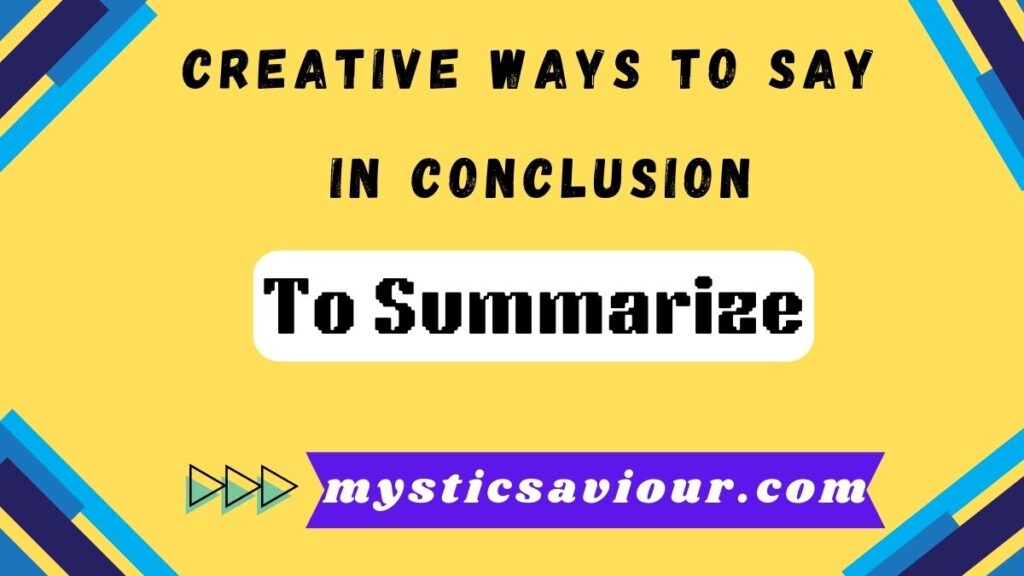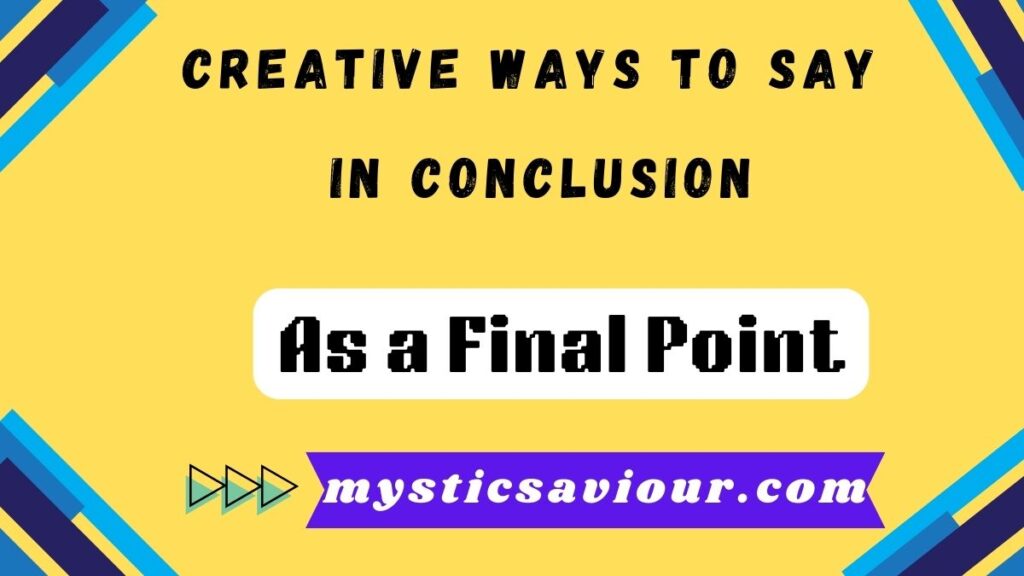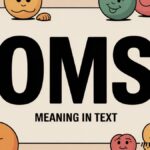13 Creative Ways to Say “In Conclusion” in Your Essay (With Examples) refers to alternative phrases that can be used to signal the end of an essay. Instead of relying on the traditional “in conclusion,” these alternatives offer a more engaging and sophisticated way to wrap up your thoughts. Using varied concluding phrases not only improves the flow of your essay but also helps leave a stronger impact on your reader.
Imagine finishing your essay with a statement that feels fresh, dynamic, and memorable. By using 13 creative ways to say “in conclusion” in your essay, you elevate the overall tone and structure of your writing. This small change can make a big difference in how your reader perceives the final message of your work.
In this article, we will break down the 13 creative ways to say “in conclusion” in your essay (with examples), giving you a variety of options to choose from. Whether you’re writing a formal research paper or a casual blog post, these alternatives will help you craft a conclusion that feels natural, thoughtful, and impactful.
Why Avoid “In Conclusion”?
In academic writing, how you signal the end of your essay can affect its tone and impact. The phrase “in conclusion” has become a bit of a cliché, and while it’s still perfectly acceptable in many contexts, it’s often better to mix things up. Using a variety of conclusion phrases can help enhance your writing style, improve flow, and maintain the reader’s interest.
Moreover, a well-crafted concluding statement helps reinforce your overall message while also ensuring your essay doesn’t feel too repetitive or predictable. Let’s dive into 13 alternatives to “in conclusion” and examine how to use them.
1. To Summarize

This phrase is a great option when you want to restate your key points in a straightforward way. It indicates that you’re about to offer a concise summary of everything discussed.
Example:
To summarize, the rapid adoption of renewable energy technologies is essential to combating climate change and ensuring a sustainable future.
Using “to summarize” provides a sense of closure while allowing you to reinforce the central themes of your essay in a brief yet powerful way.
2. Ultimately
Ultimately is perfect for concluding persuasive essays or essays where the final outcome is the focus. It draws attention to the ultimate result of your argument or discussion.
Example:
Ultimately, the most effective way to address income inequality is through comprehensive social reform that prioritizes the needs of marginalized communities.
This phrase emphasizes the final conclusion and aligns well with argumentative essays or discussions centered around significant decisions or actions.
3. All Things Considered
This phrase works well when you’ve presented several viewpoints or arguments and need to acknowledge the complexity of the issue. It signals that after considering all the evidence, you’re presenting your final thought.
Example:
All things considered, while social media can be a powerful tool for connection, it also poses significant challenges to individual privacy.
Incorporating “all things considered” shows a balanced perspective and encourages the reader to reflect on multiple facets of the topic.
4. In Essence
When you want to distill your argument to its most fundamental point, “in essence” is an ideal choice. It signals that you’re offering a boiled-down version of the main idea.
Example:
In essence, the future of our planet depends on transitioning to a low-carbon economy and embracing sustainable practices.
“In essence” allows you to simplify complex ideas while still reinforcing the key takeaway of your essay.
5. As a Final Point

If you want to introduce your final argument or closing thought, this phrase is ideal. It works well for essays that focus on a single, powerful message in the conclusion.
Example:
As a final point, it’s crucial that we invest in education to break the cycle of poverty and build a more equitable society.
Using this phrase lets you clearly emphasize the final and often most significant idea in your essay.
6. In Summary
In summary is an effective and concise way to signal that you’re about to recap the main points or provide a final synthesis of your argument.
Example:
In summary, while remote working offers flexibility and cost savings, it also requires a significant adjustment in how we communicate and collaborate in the workplace.
This phrase is simple and to the point, making it a great choice for essays that require a brief overview without extra elaboration.
7. To Sum Up
This is another casual yet effective way to bring your essay to a close. “To sum up” is often used in both written and spoken contexts and is suitable for a conversational writing style.
Example:
To sum up, the key to overcoming the environmental crisis is a global commitment to reducing carbon emissions and investing in green technologies.
It’s less formal than some of the other options but still highly effective for presenting a final summary.
8. In Closing
This phrase works well in formal and informal contexts, providing a graceful transition into the conclusion. It signals that you’re wrapping things up, often offering a final reflection or call to action.
Example:
In closing, we must acknowledge that the challenges posed by artificial intelligence will require a collective global effort to ensure ethical development.
“In closing” is a great way to end on a thoughtful or impactful note, making it especially suitable for persuasive essays or speeches.
9. To Wrap Things Up

This is a more casual and conversational way to signal the end of your essay. It’s less formal than others but works well in personal essays or creative writing, where tone is a little more relaxed.
Example:
To wrap things up, it’s clear that adopting healthier lifestyles can drastically improve mental and physical well-being.
“To wrap things up” feels approachable and helps keep the tone relaxed and informal, which is perfect for some essays or blog posts.
10. On the Whole
This phrase suggests that you’re providing an overall evaluation after considering all aspects of the argument. It’s suitable for essays that look at a topic from multiple angles.
Example:
On the whole, while the benefits of globalization are significant, it’s important to also address the inequalities it creates.
“On the whole” emphasizes comprehensive analysis and final judgment after considering the bigger picture.
11. In the Final Analysis
This is an excellent choice for analytical essays or situations where you’re presenting a comprehensive evaluation of a topic. It signals that, after all the details and discussions, you’re providing the ultimate synthesis of your argument.
Example:
In the final analysis, preserving biodiversity is not just an environmental issue but a moral obligation we must address for the good of all species.
It’s often used in academic writing and serves as a clear indicator of logical conclusion after an in-depth examination of the topic.
12. After All Is Said and Done
This phrase offers a reflective and slightly casual tone, perfect for situations where you want to show that, despite any complexities, you’ve reached a definitive conclusion.
Example:
After all is said and done, the decision to implement universal healthcare will likely improve quality of life across the nation.
It’s a slightly more informal option but still works well for persuasive essays or personal reflections on an issue.
13. In Retrospect

When you want to add a reflective tone to your conclusion, “in retrospect” is a great option. It works particularly well when you’re looking back on a series of events or an ongoing issue.
Example:
In retrospect, we can see that the push for renewable energy came too late, but it’s not too late to make meaningful change.
This phrase allows for a reflective closing thought, which can be particularly poignant in essays discussing past events or long-term issues.
Conclusion
CIn conclusion, exploring 13 creative ways to say “in conclusion” in your essay can make a significant difference in how your final thoughts are perceived. By using fresh and varied phrases, you can avoid sounding repetitive while adding depth and sophistication to your writing. These alternatives allow you to signal your essay’s end more naturally and effectively, matching the tone of your work.
Ultimately, choosing the right way to wrap up your essay is crucial. With the 13 creative ways to say “in conclusion” in your essay (with examples), you now have a range of options to strengthen your conclusion and leave a lasting impression. Whether formal or casual, these alternatives will help you connect better with your reader and bring your essay to a strong, impactful close.

Sophie Bell is a creative writer at Mystic Saviour, specializing in Word Mechanics, Name Narratives, and Linguistic Twists. She brings a passion for language and storytelling, helping readers explore unique and engaging ways to enhance their writing.










